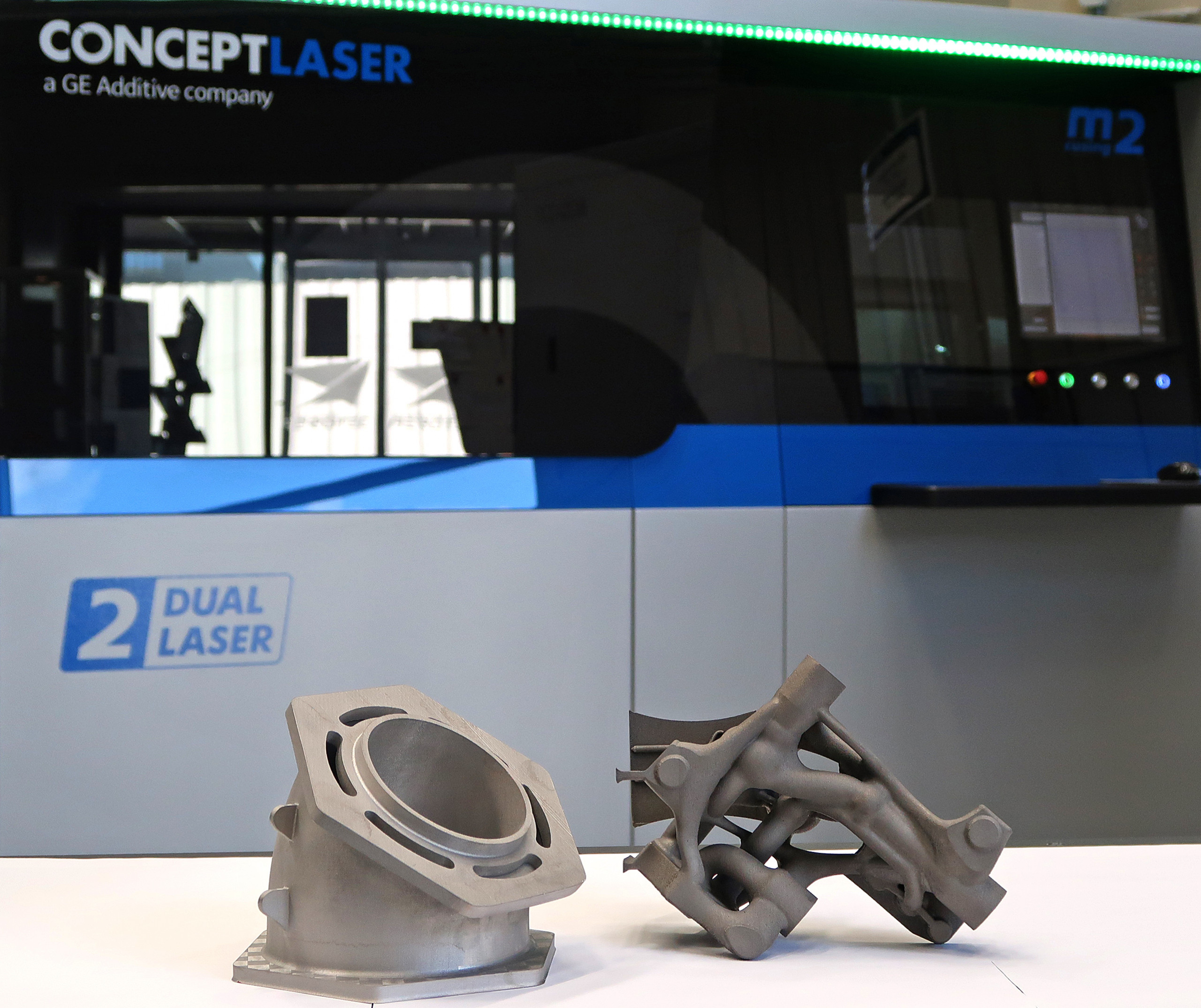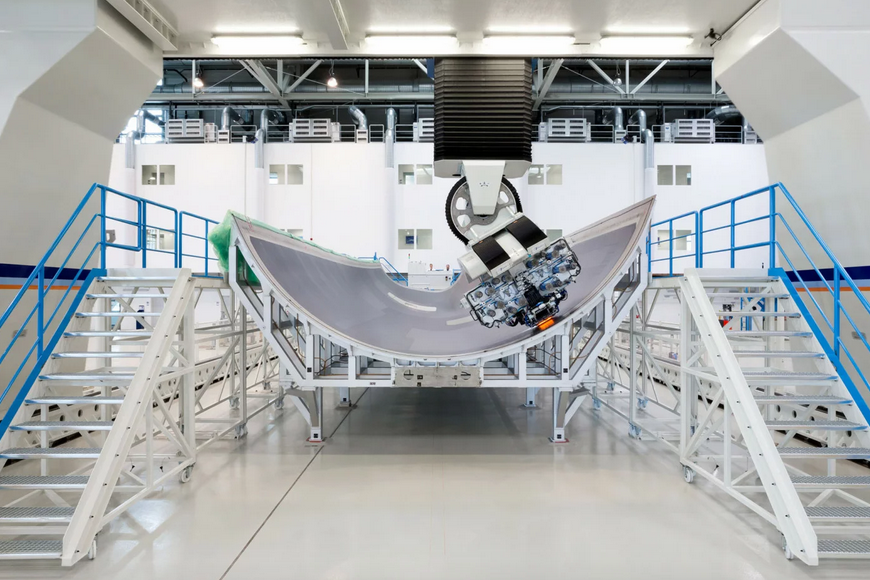Two Lasers Can Now Work on One Part: Premium Aerotec Certifies GE Additive Metal 3D Printing for Airbus
Airbus subsidiary Premium Aerotec will use GE Additive’s newly validated multi-laser Concept Laser M2 system to produce titanium components for the Airbus A320 airliner family. An aerospace supplier, Premium Aerotec and GE Additive have been partnering on the serial production of titanium parts for the aerospace industry for over five years now. Through their collaboration, they have reached a new milestone with the validation of a part that was produced in line with the process qualification requirements using two corresponding lasers and allowing a major productivity increase.
Until recently, only parts that were built with a single laser on GE Additive’s multi-laser machine could qualify for aerospace, a limitation that affected the productivity of the machines and the technology. According to a recent webinar by GE Additive’s Udo Burggraf, Senior Global and Key Account Director, and Thomas Bielefeld, Head of AM at Premium Aerotec, the stitching zones of the different lasers were critical focal points for qualification. The stitching zone is the process-critical location where the exposure areas of the lasers overlap. However, since 2019, when the process qualification for titanium components on the Concept Laser M2 system was successfully validated, the focus of the collaboration turned toward increasing the productivity of additive manufacturing (AM).

A printed titanium vent bend and a titanium brake manifold in front of a GE Additive Concept Laser M2 multi-laser system. Image courtesy of Premium Aerotec
Multi-laser systems such as the Concept Laser M2 promise a significant increase in the build rate. But until recently, qualification had been limited to the parallel assembly of several components in the build chamber of the system, with one laser being assigned to each part. For those components that occupy much of the available space in the machine, due to their dimensions, productivity could not be increased by using several lasers in parallel.
On this topic, Burggraf suggested multi-laser technology is one way to increase productivity in AM, mainly because it scales quite nicely when printing a large number of similar parts in the same build job. But when attempting to manufacture larger parts – which means fewer components can be accommodated in the build chamber – manufacturers can either shut down lasers and lose productivity, or allow multiple lasers to produce the same part, which is what the partnering companies ended up doing.
This stitching zone limitation has now been removed following the successful validation of the process, by customer Airbus, using multiple lasers to build one component. Prerequisites for proper stitching include the highest precision in the calibration of the optical systems and sophisticated compensation of the influence of the process heat, for example, which is necessary to achieve the desired material properties. Thanks to the certification of the process using corresponding lasers to additively manufacture titanium components, Premium Aerotec and GE Additive have recently achieved another turning point in the serial production of metal 3D printed components for the aerospace industry.
AM is becoming increasingly important to the serial production of components for aviation, and so are laser systems. In just a few years, powder bed fusion (PBF) systems went from single- to double- to quad-laser systems, and now we’ve jumped into a new multi-laser era, opening up new opportunities for build rates in industrial settings.
However, as 3DPrint.com Executive Editor Joris Peels points out, adding more lasers to a machine does not necessarily equal greater productivity, due the complexity of multiple energy sources overlapping and changing the physics of the build process. Here, Premium Aerotec and GE Additive have demonstrated how far they’ve come with just two lasers. Now, we’ll need to see the same certification applied to eight, nine, 10, and 12 lasers.
GE Additive’s Concept Laser 3D metal printer division relies on a patented technology that uses lasers to melt layers of fine metal powder and create complex metal 3D geometries with incredible precision. Launched in November 2019, it’s Concept Laser M2 Series 5 system is a dual laser system with a build volume of 250x250x350 cubic millimeters and a 3D optic with variable spot diameter. The current generation of the system was developed to meet the exacting demands of highly regulated industries, including aerospace and medicine, in terms of accuracy, uniformity, repeatability, and safety.
“With this advanced technology, we are now able to achieve a homogeneous, quasi-isotropic structure with excellent material properties in the overlap area, which does not show any discernible differences from the previous quality standard. At the same time, with our partner GE Additive, we have succeeded in increasing productivity in component production by more than 30 percent”, said Bielefeld.
The partners are already planning the next steps to significantly increase achievable build rates and in turn, make AM economically attractive for an expanded range of parts. The collaboration is part of a cooperation agreement signed in 2016 which outlined a rather complete working relationship for the industrialization of 3D metal printing in aircraft construction.
Subscribe to Our Email Newsletter
Stay up-to-date on all the latest news from the 3D printing industry and receive information and offers from third party vendors.
You May Also Like
Profiling a Construction 3D Printing Pioneer: US Army Corps of Engineers’ Megan Kreiger
The world of construction 3D printing is still so new that the true experts can probably be counted on two hands. Among them is Megan Kreiger, Portfolio Manager of Additive...
US Army Corps of Engineers Taps Lincoln Electric & Eaton for Largest 3D Printed US Civil Works Part
The Soo Locks sit on the US-Canadian border, enabling maritime travel between Lake Superior and Lake Huron, from which ships can reach the rest of the Great Lakes. Crafts carrying...
Construction 3D Printing CEO Reflects on Being Female in Construction
Natalie Wadley, CEO of ChangeMaker3D, could hear the words of her daughter sitting next to her resounding in her head. “Mum, MUM, you’ve won!” Wadley had just won the prestigious...
1Print to Commercialize 3D Printed Coastal Resilience Solutions
1Print, a company that specializes in deploying additive construction (AC) for infrastructure projects, has entered an agreement with the University of Miami (UM) to accelerate commercialization of the SEAHIVE shoreline...































